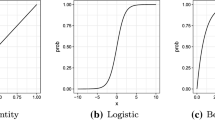Abstract
Non-negative matrix factorization (NMF) is a technique of multivariate analysis used to approximate a given matrix containing non-negative data using two non-negative factor matrices that has been applied to a number of fields. However, when a matrix containing non-negative data has many zeroes, NMF encounters an approximation difficulty. This zero-inflated situation occurs often when a data matrix is given as count data, and becomes more challenging with matrices of increasing size. To solve this problem, we propose a new NMF model for zero-inflated non-negative matrices. Our model is based on the zero-inflated Tweedie distribution. The Tweedie distribution is a generalization of the normal, the Poisson, and the gamma distributions, and differs from each of the other distributions in the degree of robustness of its estimated parameters. In this paper, we show through numerical examples that the proposed model is superior to the basic NMF model in terms of approximation of zero-inflated data. Furthermore, we show the differences between the estimated basis vectors found using the basic and the proposed NMF models for \(\beta \) divergence by applying it to real purchasing data.









Similar content being viewed by others
Notes
This was ordered by the Joint Association Study Group of Management Science for a data analysis competition in 2014.
References
Berry MW, Browne M, Langville AN, Pauca VP, Plemmons RJ (2007) Algorithms and applications for approximate non-negative matrix factorization. Comput Stat Data Anal 52(1):155–173
Cichocki A, Amari S (2010) Families of alpha-beta-and gamma-divergences: flexible and robust measures of similarities. Entropy 12(6):1532–1568
De Leeuw J, Van der Heijden PGM, Verboon P (1990) A latent time–budget model. Stat Neerl 44(1):1–22
Dunn PK, Smyth GK (2001) Tweedie family densities: methods of evaluation. In: Proceedings of the 16th international workshop on statistical modelling. Odense, Denmark, pp 2–6
Dempster AP, Laird NM, Rubin DB (1977) Maximum likelihood from incomplete data via the EM algorithm. J R Stat Soc Ser B (methodological) 39(1):1–38
Févotte C, Bertin N, Durrieu JL (2009) Non-negative matrix factorization with the Itakura–Saito divergence: with application to music analysis. Neural Comput 21(3):793–830
Févotte C, Idier J (2011) Algorithms for non-negative matrix factorization with the \(\beta \)-divergence. Neural Comput 23(9):2421–2456
Jorgensen B (1997) The theory of dispersion models. CRC Press, Chapman and Hall, London
Lambert D (1992) Zero-inflated Poisson regression, with an application to defects in manufacturing. Technometrics 34(1):1–14
Lee DD, Seung S (1999) Learning the parts of objects by non-negative matrix factorization. Nature 401:788–791
Lee DD, Seung HS (2001) Algorithms for non-negative matrix factorization. Adv Neural Inf Process Syst 13:556–562
McLachlan G, Krishnan T (2007) The EM algorithm and extensions, vol 382. Wiley, Hoboken
Nakano M, Kameoka H, Roux LJ, Kitano Y, Ono N, Sagayama S (2010) Convergence-guaranteed multiplicative algorithms for non-negative matrix factorization with divergence. In: Proceedings of the 2010 IEEE international workshop on machine learning for signal processing (MLSP), pp 283–288
Paez F, Vanegas JA, Gonzalez FA (2013) An evaluation of NMF algorithm on human action video retrieval. In: Image, signal processing, and artificial vision (STSIVA), 2013 XVIII symposium of IEEE, pp 1–4
Simchowitz M (2013) Zero-inflated Poisson factorization for recommendation systems. Academia.edu. https://www.academia.edu/6256225/Zero-Inflated_Poisson_Factorization_for_Recommendation_Systems
Schachtner R (2010) Extensions of non-negative matrix factorization and their application to the analysis of wafer test data. Doctoral dissertation
Şimşekli U, Cemgil A, Yılmaz YK (2013) Learning the beta-divergence in Tweedie compound Poisson matrix factorization models. In: Proceedings of the 30th international conference on machine learning (ICML-13), pp 1409–1417
Tan VYF, Févotte C (2013) Automatic relevance determination in non-negative matrix factorization with the \(\beta \)-divergence. IEEE Trans Pattern Anal Mach Intell 35(7):1592–1605
Xu W, Liu X, Gong Y (2003) Document clustering based on non-negative matrix factorization. In: Proceedings of the 26th annual international ACM SIGIR conference on research and development in information retrieval, pp 267–273
Zhang Y (2013) Likelihood-based and Bayesian methods for Tweedie compound Poisson linear mixed models. Stat Comput 23(6):743–757
Acknowledgments
We wish to express our appreciation to the editor and referees for their insightful comments, which have helped us signicantly improve the paper. We are also grateful to the Joint Association Study Group of Management Science for providing the data used in our application.
Author information
Authors and Affiliations
Corresponding author
Appendix: Proof of (25)
Appendix: Proof of (25)
\( {\text {Case of } \beta < 1}\)
The differential of the auxiliary function (17) is given by
The update equation for \(f_{im}\) is derived from (30) when it is zero, as follows:
\( {\text {Case of } 1 \le \beta \le 2}\)
The differential of the auxiliary function (17) is given by
The update equation for \(f_{im}\) is derived from (32) when it is zero, as follows:
\( {\text {Case of }\beta > 2}\)
The differential of the auxiliary function (17) is given by
The update equation for \(f_{im}\) is derived from (34) when it is zero, as follows:
We obtain (25) replacing \(f_{im}\), \(a_{jm}\), \(\lambda _{ijm}\), and \(\eta _{ij}\) to \(f_{im}^{(t)}\), \(a_{jm}^{(t-1)}\), \(\lambda _{ijm}^{(f)}\), and \(\eta _{ij}^{(f)}\), respectively in (30), (32), and (34). \(\blacksquare \)
Rights and permissions
About this article
Cite this article
Abe, H., Yadohisa, H. A non-negative matrix factorization model based on the zero-inflated Tweedie distribution. Comput Stat 32, 475–499 (2017). https://doi.org/10.1007/s00180-016-0689-8
Received:
Accepted:
Published:
Issue Date:
DOI: https://doi.org/10.1007/s00180-016-0689-8




